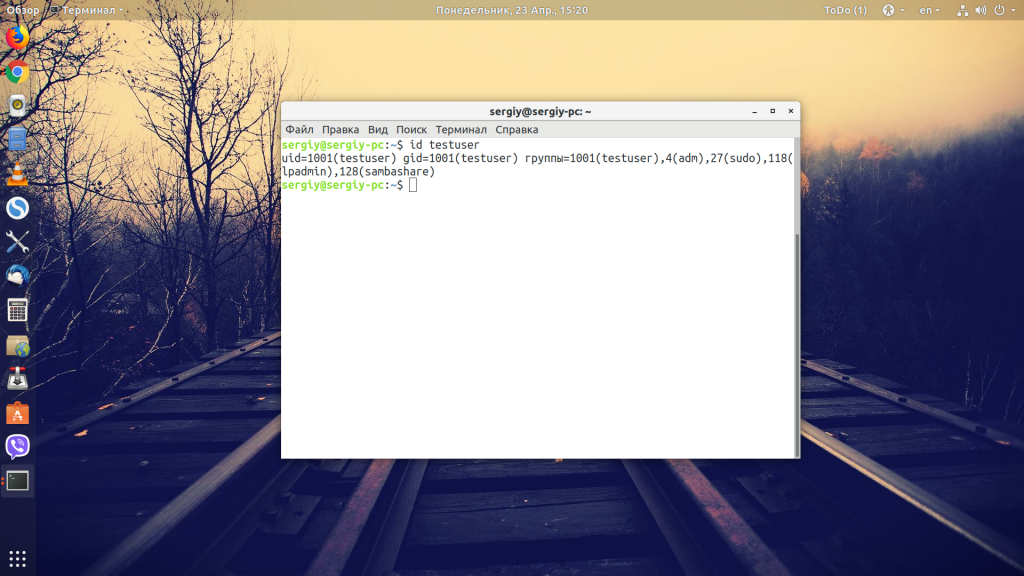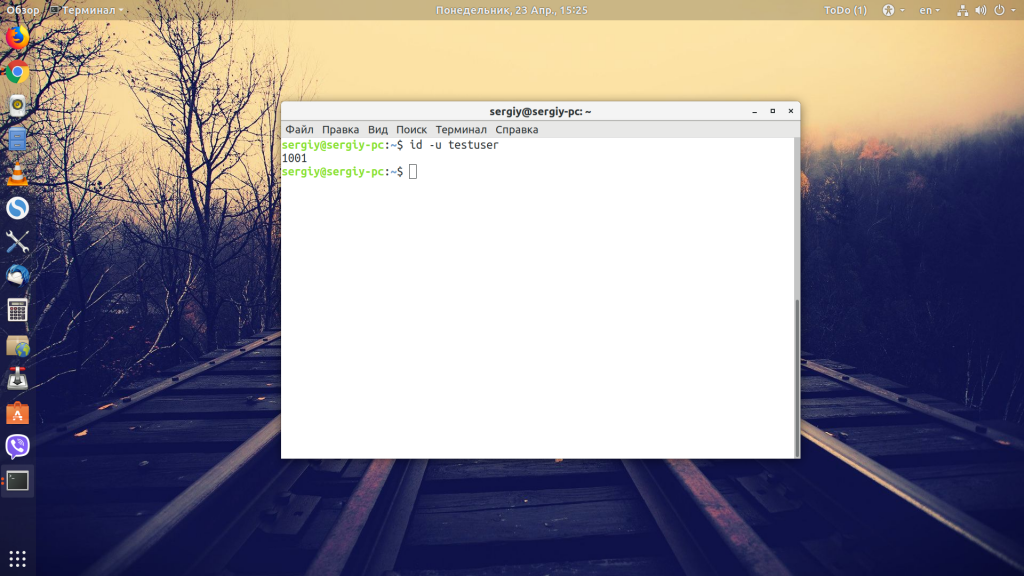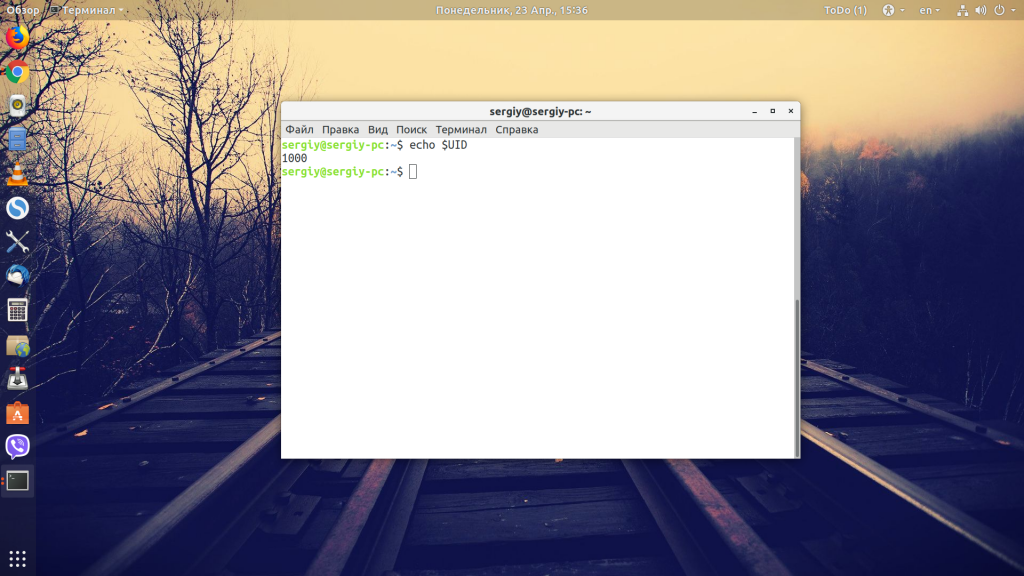- Everything Important You Need to Know About UID in Linux
- What is UID in Linux?
- How to find the UID of a user in Linux?
- How to change UID of a user in Linux?
- How does UID associate with different system resources? [for advanced users]
- UID and files
- UID and processes
- Как узнать id пользователя Linux
- Как узнать id пользователя в Linux
- Выводы
- 5 Ways to find a Linux User ID (UID) in Ubuntu 20.04
- 5 Ways of Finding the UID in Ubuntu Linux
- Method # 1: Using the “id” Command
- Method # 2: Using the “id” Command with Username
- Method # 3: Using the “getent” Command
- Method # 4: Using the “lslogins” Utility
- Method # 5: Using the “grep” Command
- Conclusion
- Search
- About This Site
- Latest Tutorials
Everything Important You Need to Know About UID in Linux
This Linux Basics guide teaches you everything important associated with UID in Linux.
What is UID in Linux?
UID stands for user identifier. A UID is a number assigned to each Linux user. It is the user’s representation in the Linux kernel. The UID is used for identifying the user within the system and for determining which system resources the user can access. This is why the user ID should be unique.
You can find UID stored in the /etc/passwd file. This is the same file that can be used to list all the users in a Linux system.
Use a Linux command to view text file and you’ll see various information about the users present on your system.
root:x:0:0:root:/root:/bin/bash daemon:x:1:1:daemon:/usr/sbin:/usr/sbin/nologin bin:x:2:2:bin:/bin:/usr/sbin/nologin sys:x:3:3:sys:/dev:/usr/sbin/nologin sync:x:4:65534:sync:/bin:/bin/sync games:x:5:60:games:/usr/games:/usr/sbin/nologin man:x:6:12:man:/var/cache/man:/usr/sbin/nologin lp:x:7:7:lp:/var/spool/lpd:/usr/sbin/nologin mail:x:8:8:mail:/var/mail:/usr/sbin/nologin news:x:9:9:news:/var/spool/news:/usr/sbin/nologin johndoe:x:1000:1000:John Doe. /home/helder:/bin/bash davmail:x:127:65534::/var/lib/davmail:/usr/sbin/nologin statd:x:128:65534::/var/lib/nfs:/usr/sbin/nologinThe third field here represents the user ID or UID.
Do note that in most Linux distributions, UID 1-500 are usually reserved for system users. In Ubuntu and Fedora, UID for new users start from 1000.
For example, if you use adduser or useradd command to create a new user, it will get the next available number after 1000 as its UID.
How to find the UID of a user in Linux?
You can always rely on the /etc/passwd file to get the UID of a user. That’s not the only way to get the UID information in Linux.
The id command in Linux will display the UID, GID and groups your current user belongs to:
id uid=1000(abhishek) gid=1000(abhishek) groups=1000(abhishek),4(adm),24(cdrom),27(sudo),30(dip),46(plugdev),116(lpadmin),126(sambashare),127(kvm)You can also specify the user names with the id command to get the UID of any Linux user:
id standard uid=1001(standard) gid=1001(standard) groups=1001(standard)How to change UID of a user in Linux?
Suppose you had several users on your Linux system. You had to delete a user because he/she left the organization. Now you want its UID to be taken by another user already on the system.
You can change the UID by modifying the user using usermod command like this:
You need to have superuser privilege to execute the above command.
Do you remember the file permission and ownership concept in Linux? The ownership of a file is determined by the UID of the owner user.
When you update the UID of a user, what happens to the files owned by this user?While all the files in the home directory of user_2 will have their associated UID changed, you’ll have to manually update the associated UID of other files outside the home directory.
What you can do is manually update the ownership of the files associated with the old UID of the user_2.
find / -user old_uid_of_user_2 -exec chown -h user_2 <> \;How does UID associate with different system resources? [for advanced users]
UIDs are unique to one another and thus they can also be used to identify ownership of different system resources such as files and processes.
UID and files
I hope you are familiar with the file permission concept in Linux. When you’re creating a file, you’re the owner of this file. Now you can decide who gets to do what with this file. This is part of Linux’s DAC mechanism where each file is left at its owner’s discretion.
You can read a file’s ownership by using either ls or stat command. Let’s do it with the popular ls command and check the ownership of either the binary sleep or passwd .
As you can see, the file /usr/bin/sleep belongs to root:
ls -l $(which sleep) -rwxr-xr-x 1 root root 39048 Mar 6 2020 /usr/bin/sleepLet’s force it to map the ownership with UID instead of username:
ls -lhn $(which sleep) -rwxr-xr-x 1 0 0 39K Mar 6 2020 /usr/bin/sleepHere’s fun information. Your operating system doesn’t understand «usernames». Whenever a program needs to work with usernames or needs to print such, it refers to the /etc/passwd file to extract the information.
You don’t have to take my words for it. See it yourself with strace program which prints all the system calls made by a program.
strace ls -lhn $(which sleep) 2>&1 | grep passwd What you are trying to see is whether ls command is trying to read the /etc/passwd file or not.
strace ls -lh $(which sleep) 2>&1 | grep passwd openat(AT_FDCWD, "/etc/passwd", O_RDONLY|O_CLOEXEC) = 6UID and processes
Processes have owners too, just like files. Only the owner (or the root user) of a process can send process signals to it. This is where the UID comes into play.
If a normal user tries to kill a process owned by another user, it will result in error:
kill 3708 bash: kill: (3708) - Operation not permittedOnly the owner of the process or the root can do this.
A process must be regulated. Regulated as in you need to have a way to limit or know how much a process is allowed to do. This is determined by its UID(s).
There are three types of UIDs associated with a process.
- Real UID: Real UID is the UID that a process adopts from its parent. In easier terms, whoever starts a process, the UID of that user is the real UID of the process. This is helpful in identifying who a process really belongs to. This is essential especially when the effective UID is not the same as the real UID which I’m going to talk about next.
- Effective UID: This is what mostly determines what permissions a certain process really has. While a user can start the process, it can run with a different user’s available permissions. The command passwd is one example of this. This program edits the file /etc/shadow , which is root owned. Therefore, a normal user shouldn’t be able to run this command or change his/her password. Luckily, the binary runs with an effective UID of 0 (i.e. root), which enables it to have enough privilege to edit the /etc/shadow file. Real and effective UIDs are mostly the same except in the case of SUID bit enabled binaries.
- Saved UID: UID that’s available at a process’s disposal. This one is not normally used, but is still there in case the process knows it’s not going to perform any privileged work, so it can change its effective UID to something that’s unprivileged. This reduces the surface of an unintentional misbehavior.
That’s it. I hope you have a better idea about UID in Linux now. Don’t hesitate to ask your questions, if any.
As a pro Linux user, if you think I missed some important concept about UID, please let me know in the comment section.
Как узнать id пользователя Linux
Иногда возникает необходимость узнать id пользователя Linux. Это может понадобиться, если вы хотите вручную добавить группу для пользователя или вам нужно выполнить другие операции с файлами /etc/passwd или /etc/shadow.
В этой небольшой заметке мы поговорим о том, как посмотреть id пользователя с помощью различных команд в Linux.
Как узнать id пользователя в Linux
Самый простой способ посмотреть идентификатор текущего пользователя — использовать команду id, она выводит не только сам UID, но и идентификатор группы пользователя, а также основные группы этого пользователя:
Первым выводится именно id пользовтеля. Если вам нужно узнать информацию о другом пользователе, вы можете передать его имя в параметры утилиты:
Когда необходимо вывести только id пользователя:
Если вам надо узнать только id группы определенного пользователя, то используйте опцию -g:
Есть ещё несколько способов посмотреть id. Например, для текущего пользователя его можно найти в переменной окружения UID:
Ещё один вариант — утилита getent:
getent passwd имя_пользователя
Или смотрим содержимое файла /etc/passwd с помощью команды grep:
grep имя_пользователя /etc/passwd
Здесь первый цифровой параметр — это сам id, а второй, который расположен за двоеточием, — это GID.
Выводы
В этой небольшой статье мы рассмотрели, как узнать id пользователя Linux. Если у вас остались вопросы, спрашивайте в комментариях!

Обнаружили ошибку в тексте? Сообщите мне об этом. Выделите текст с ошибкой и нажмите Ctrl+Enter.
5 Ways to find a Linux User ID (UID) in Ubuntu 20.04
The User ID or UID in Linux is a unique entity through which a user is identified on a system. Every user on a Linux system has a dedicated UID. There are several ways of finding the UID of a Linux user and we are going to share with you all those ways for an Ubuntu or Linux Mint system.
5 Ways of Finding the UID in Ubuntu Linux
There are five main methods for finding the UID in Linux Mint 20 which are as follows:
Method # 1: Using the “id” Command
For using the “id” command to find the UID of the currently logged in user in Ubuntu, you have to execute it in the following manner:
The UID of our currently logged in user is highlighted in the image shown below:
Method # 2: Using the “id” Command with Username
The “id” command can also be paired up with the username of your desired user to get that user’s UID in the following manner:
Replace username with the name of the user whose UID you want to find out.
The UID of our specified user is shown in the image below:
Method # 3: Using the “getent” Command
To use the “getent” command for finding the UID in Linux Mint 20, you will have to execute it in the following manner:
Replace username with the name of the user whose UID you want to find out.
The UID of our specified user is shown in the image below:
Method # 4: Using the “lslogins” Utility
For using the “lslogins” utility to find the UID in Linux Mint 20, you will have to execute the following command:
This utility will present you with a list of all of your system users along with their respective UIDs as shown in the image below:
Method # 5: Using the “grep” Command
The “grep” command can also be used for finding the UID of the specified user in Ubuntu in the following manner:
Replace username with the name of the user whose UID you want to find out.
The UID of our specified user is shown in the image below:
Conclusion
By picking out any method of your choice from this tutorial, you will be able to find the UID of any user you want while using Ubuntu 20.04. All the commands and utilities that we have used for this tutorial are built-in. Therefore, you will not have to waste your precious time in installing anything while following this tutorial.
Search
About This Site
Vitux.com aims to become a Linux compendium with lots of unique and up to date tutorials.













